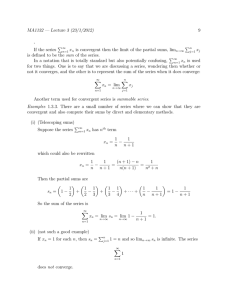10.2 - Series
advertisement
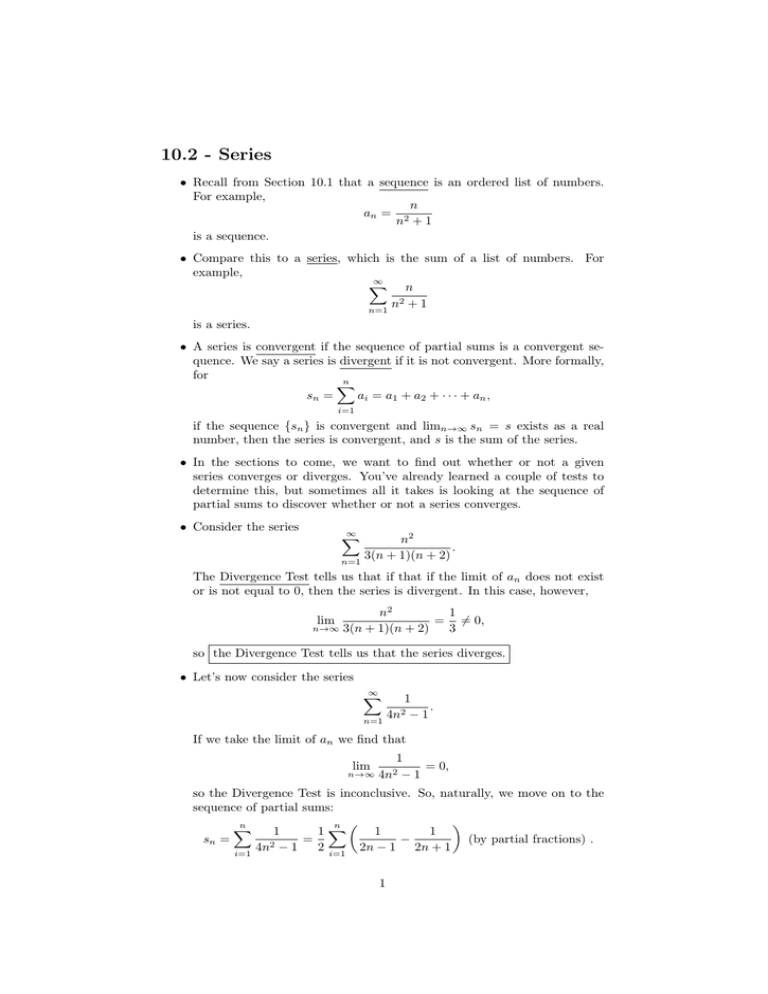
10.2 - Series
• Recall from Section 10.1 that a sequence is an ordered list of numbers.
For example,
n
an = 2
n +1
is a sequence.
• Compare this to a series, which is the sum of a list of numbers. For
example,
∞
∑
n
2
n +1
n=1
is a series.
• A series is convergent if the sequence of partial sums is a convergent sequence. We say a series is divergent if it is not convergent. More formally,
for
n
∑
sn =
ai = a1 + a2 + · · · + an ,
i=1
if the sequence {sn } is convergent and limn→∞ sn = s exists as a real
number, then the series is convergent, and s is the sum of the series.
• In the sections to come, we want to find out whether or not a given
series converges or diverges. You’ve already learned a couple of tests to
determine this, but sometimes all it takes is looking at the sequence of
partial sums to discover whether or not a series converges.
• Consider the series
∞
∑
n2
.
3(n + 1)(n + 2)
n=1
The Divergence Test tells us that if that if the limit of an does not exist
or is not equal to 0, then the series is divergent. In this case, however,
n2
1
= ̸= 0,
n→∞ 3(n + 1)(n + 2)
3
lim
so the Divergence Test tells us that the series diverges.
• Let’s now consider the series
∞
∑
n=1
1
.
−1
4n2
If we take the limit of an we find that
lim
n→∞
1
= 0,
4n2 − 1
so the Divergence Test is inconclusive. So, naturally, we move on to the
sequence of partial sums:
)
n
n (
∑
1
1∑
1
1
sn =
=
−
(by partial fractions) .
4n2 − 1
2 i=1 2n − 1 2n + 1
i=1
1
If we expand this out, we obtain
[(
) (
) (
)
(
) (
)]
1
1
1 1
1 1
1
1
1
1
1−
+
−
+
−
+ ··· +
−
+
−
2
3
3 5
5 7
2n − 3 2n − 1
2n − 1 2n + 1
These terms cancel to give us
(
)
1
1
1
sn =
1−
⇒ lim sn = ,
n→∞
2
2n + 1
2
and our series converges to 12 .
• Let’s consider one more example from this section:
∞
∑
(
ln
n=1
n
2n + 5
)
.
Let’s first look at the limit of the associated series:
(
)
(
)
(
)
( )
n
1
n
1
lim ln
= ln lim
= ln lim
= ln
̸= 0.
n→∞
n→∞ 2n + 5
n→∞ 2
2n + 5
2
Thus, the series diverges by the Divergence Test.
10.3 - The Integral and Comparison Tests; Estimating Sums
• In this section, we learned about the Integral Test, which is as follows:
Suppose f is a continuous, positive,
∑∞ decreasing function on [1, ∞) and
let an = f (n). Then
the
series
n=1 an is convergent if and only if the
∫∞
improper integral 1 f (x)dx is convergent.
• In applying this, consider the series
∞
∑
1
.
n(ln
n)p
n=2
For what values of p is this series convergent? The limit of an does not
look too friendly in this example and neither does the sequence of partial
sums, so let’s consider the function f (x) = x(ln1x)p . It’s derivative is given
p+ln x
−p
. This implies that,
by f ′ (x) = − x2 (ln
x)p+1 which is negative for x > e
at some point, f is eventually decreasing, so we can use the Integral Test.
Now
[∫ ∞
[
]
]
∫ ∞
(ln R)1−p
1
(ln 2)1−p
1
dx = lim
dx = lim
−
.
R→∞
R→∞
x(ln x)p
x(ln x)p
1−p
1−p
2
2
This limit exists whenever 1−p < 0 ⇒ p > 1, so the series converges for p > 1.
(The p = 1 case is explained in Exercise 11.)
2


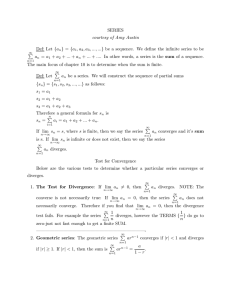
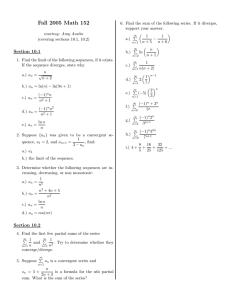
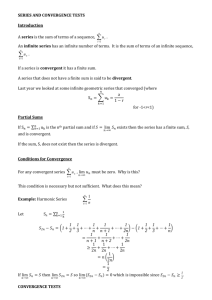
![MA342A (Harmonic Analysis 1) Tutorial sheet 8 [December 10, 2015] Name: Solutions √](http://s2.studylib.net/store/data/010415901_1-00035e0c3b9d31c812df276d6fe8c92d-300x300.png)

